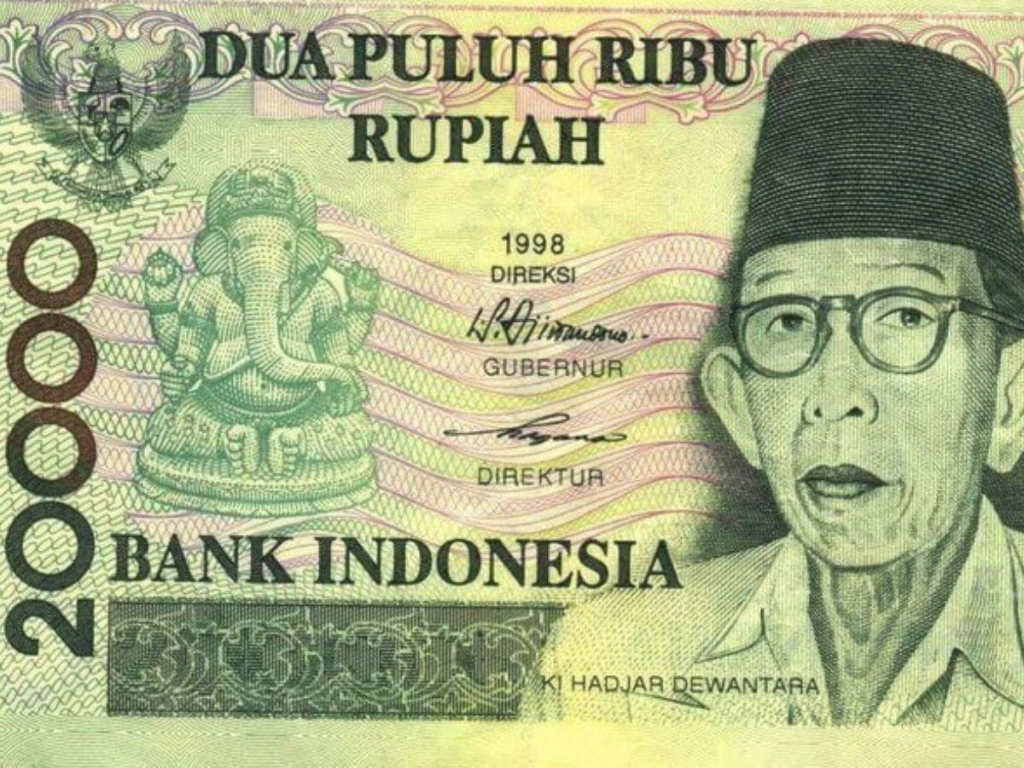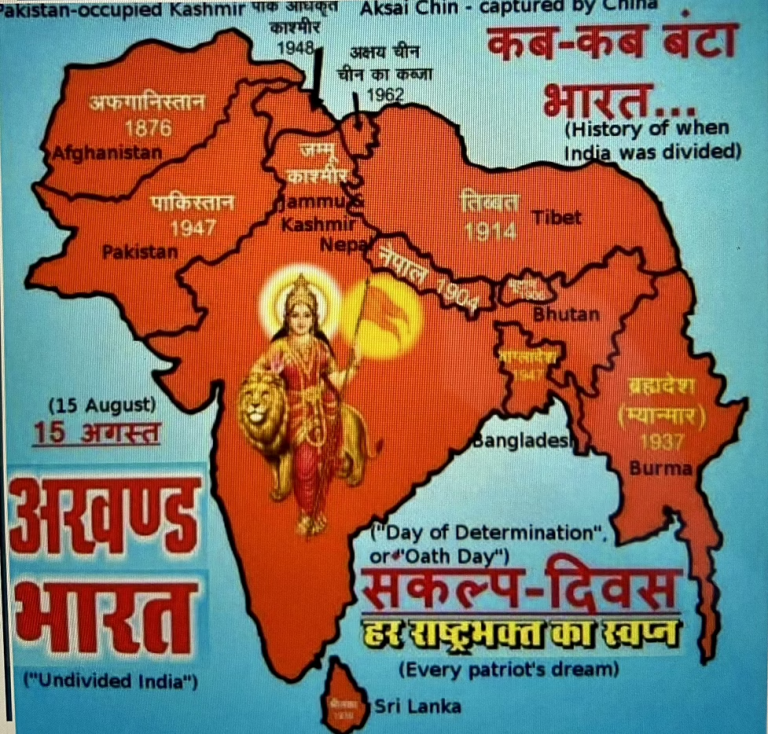Akhand Bharat – Concept based on truth – An Article by Professor Vivek Singh
Tracing the Roots: India’s Legacy in Ancient Wisdom and Global Enlightenment
In Sanskrit ceremonies of Hinduism, during the Sankalpa ritual, it’s stated that Bharat (India) lies within ‘Jambudweep’.
Indian culture, deeply rooted and extensive, stands as a remarkable example globally. The land currently known as India, historically referred to as Aryavarta, is among the world’s most ancient civilizations.
India has long been a beacon of knowledge, scientific innovation, and cultural richness. In times when global knowledge was limited, India emerged as a pivotal source of enlightenment, disseminating wisdom across the globe.

Fragmentation Through the Ages: The Historical Division and Reshaping of India’s Borders
Over the past 2500 years, India, historically known as Bharatavarsha or Aryavarta, faced numerous invasions and attacks, leading to its division into different entities 24 times in recorded history.
Historically, India endured invasions from various groups, including the French, Dutch, Kushans, Shaks, Yemenis, Greeks, Mughals, and British.
It’s noted that these invasions were primarily focused on India, with less historical emphasis on regions like Afghanistan, Myanmar, Sri Lanka, Nepal, Tibet, Bhutan, and Malaysia, which were considered parts of ancient Aryavarta.
Afghanistan was internationally recognized as an independent nation in 1876, Bhutan in 1906, Sri Lanka in 1935, and Pakistan in 1947. Prior to these dates, regions including Afghanistan, Bhutan, Myanmar, Pakistan, Bangladesh, Sri Lanka, and Tibet were integral parts of India.
The British, responding to the 1857 rebellion, adopted a divide and rule strategy, leading to Afghanistan’s separation from India in 1876, a process that continued until 1947.
In the times of the Mahabharata and Ramayana, regions like Malaysia, Indonesia, Thailand, Philippines, Vietnam, Cambodia were also seen as integral parts of India. Singapore was historically known as Singhpur.
Historical India stretched from the Himalayas to the Indian Ocean, and from Iran to Indonesia. In 1857, India’s area was approximately 83 lakh square kilometers, which has since reduced to about 33 lakh square kilometers.
From 1857 to 1947, India experienced multiple divisions at the hands of foreign powers. Afghanistan was separated in 1876, Nepal in 1904, Bhutan in 1906, Tibet in 1907, Sri Lanka in 1935, Myanmar in 1937, and Pakistan in 1947.

Sri Lanka
In 1935, Sri Lanka was partitioned from India by the British. Historically known as Sinhaldeep, this name was subsequently changed to Ceylon. During Emperor Ashoka’s era, it was referred to as Tamraparni. Ashoka’s son Mahendra and daughter Sanghamitra traveled to Sri Lanka to spread Buddhism. Geographically, Sri Lanka was once considered a segment of a unified Indian subcontinent.
Afghanistan
Historically, Afghanistan was known as Upganasthan, and the region of Kandahar was referred to as Gandhara. Afghanistan was predominantly influenced by Shaivism. The Gandhara mentioned in the Mahabharata, from where Gandhari, the mother of the Kauravas, and her brother Shakuni hailed, is located in present-day Afghanistan.
References to Kandahar, or Gandhara, are found up until the reign of Shah Jahan, indicating its historical connection to India. In 1876, the Gandamak Treaty was signed between Russia and Britain, leading to the international recognition of Afghanistan as an independent nation separate from India.
Myanmar (Varma)
Myanmar, formerly known as Varma, was historically referred to as Brahmadesh. In 1937, the British officially recognized Myanmar (Varma) as a distinct nation. In its ancient history, this region was ruled by the Hindu king Anandavrata.
Nepal
In ancient times, the region now known as Nepal was referred to as Deodhar. It is notable for being the birthplace of Lord Buddha in Lumbini and the birthplace of Mother Sita in Janakpur, both located within current Nepalese borders.
The British established Nepal as an independent country in 1904. For a long period, Nepal was known as the Hindu nation of Nepal, or Hindu Rashtra Nepal. The monarch of Nepal was traditionally titled Nepal Naresh until recent years.
Nepal’s population consists of 81% Hindus and 9% Buddhists. Historically, Nepal was a part of India during the reigns of Emperor Ashoka and Samudragupta. In 1951, Maharaja Tribhuvan Singh of Nepal proposed merging Nepal with India to India’s then-Prime Minister Pandit Jawaharlal Nehru, but the proposal was declined by Nehru.
Thailand
Until 1939, Thailand was historically referred to as Syam. Its prominent cities included Ayodhya and Shri Vijay. The establishment of Buddhist temples in Syam dates back to the third century. Presently, Thailand still houses numerous Shiva temples. In its capital, Bangkok, there are hundreds of Hindu temples.
Cambodia
Cambodia, originating from the Sanskrit name ‘Kamboj’, was once a part of the extensive Indian subcontinent. The region was governed by the Kaundinya dynasty, of Indian origin, from the first century. The prevalent deities worshipped were Shiva, Vishnu, and Buddha, and Sanskrit was the national language.
In contemporary Cambodia, traditional Indian months like Chet, Visakh, and Asadha are still in use.
The globally acclaimed Ankorwat temple, dedicated to Lord Vishnu, was constructed by the Hindu king Suryadev Varman. The temple’s walls are adorned with artwork depicting scenes from the Ramayana and the Mahabharata. The ancient name of Ankorwat was Yashodharpur.
Vietnam
Vietnam was historically known as Champadesh, with its main cities being Indrapur, Amravati, and Vijay. Numerous temples dedicated to Shiva, Lakshmi, Parvati, and Saraswati are still present in the region. The Shivling was also an object of worship here. The native inhabitants, known as the Cham people, were primarily followers of Shaivism.
Malaysia
Malaysia was originally known as Malay Desh, a name derived from Sanskrit meaning ‘the land of mountains’. This region is mentioned in ancient texts like the Ramayana and Raghuvansham. In Malay, Shaivism was a prevalent religious practice, with deities such as Goddess Durga and Lord Ganesha being widely worshipped. The primary script used in the region was Brahmi, and Sanskrit served as the main language.
Indonesia
Indonesia was historically known as Dipantar Bharat, a term referenced in the Puranas, meaning ‘the ocean across India’. This region was under the rule of Hindu kings. The largest Shiva temple could be found on the island of Java. Many of the temples in this area prominently featured carvings of Lord Rama and Lord Krishna. The Bhuvanakosh stands as one of the oldest texts from the region, comprising 525 verses in Sanskrit.
The names or motos of leading institutions of Indonesia are still in Sanskrit :
Indonesian Police Academy – Dharma Bijaksana Kshatriya
Indonesia National Armed Forces – Tri Dharma Ek Karma
Indonesia Airlines – Garun Airlines
Indonesia Ministry of Home Affairs – Charak Bhuvan
Indonesia Ministry of Finance – Nagar Dhan Raksha
Indonesia Supreme Court – Dharma Yukti

Tibet
Tibet was historically known as Trivishtam, and it was divided into two regions. Following an agreement between the Chinese and the British in 1907, one region was allotted to China and the other to the Lama authorities. In 1954, India’s Prime Minister Jawaharlal Nehru recognized Tibet as a part of China, as a gesture of solidarity with the Chinese people.
Bhutan
In 1906, Bhutan was established as an independent country by the British, separating it from India. The name ‘Bhutan’ originates from the Sanskrit term ‘Bhu Utthan’, which translates to ‘high ground’.
Pakistan
On August 14, 1947, India underwent a partition orchestrated by the British, resulting in the creation of Pakistan as East Pakistan and West Pakistan. Mohammad Ali Jinnah had been advocating for a separate nation based on religious lines since 1940, which eventually became Pakistan.
In 1971, with India’s support, Pakistan underwent another division, leading to the formation of Bangladesh. Both Pakistan and Bangladesh were historically part of India.
Throughout different historical periods, India has seen divisions that have led to the formation of various countries. The potential reintegration of these regions into India would involve a gradual process of merging.
Following India’s independence in 1947, Pondicherry was released from French control in 1954. Goa and Daman and Diu were liberated from Portuguese rule in 1961. In 1975, Sikkim was incorporated into India.
The regions that were once integral parts of India have since become independent nations. While challenging, the idea of integrating these countries back into India is not deemed impossible.
Concept of Akhand Bharat and its Extent
The concept of Akhand Bharat, or Undivided India, envisions an expansive region that potentially includes at least nine independent sovereign nations: India, Pakistan, Bangladesh, Bhutan, Afghanistan, Nepal, Myanmar, Sri Lanka, and Maldives.
Frequently, Akhand Bharat is believed to encompass India, Pakistan, Bangladesh, Afghanistan, Nepal, Tibet, Bhutan, and Sri Lanka. Some even suggest that the entirety of South and South-East Asia, once part of ancient Bharat (Pracheen Bharat), could fall under the Akhand Bharat ambit.
Numerous sources on the internet assert that the idea of Akhand Bharat is as ancient as the civilization that spread across modern-day countries like Afghanistan, Pakistan, India, Nepal, Burma (Myanmar), Tibet, Bhutan, and Bangladesh.
Some, in fact, go on to suggest that whole of South and South-East Asia, having been once integral to Pracheen Bharat, could be included in Akhand Bharat.

Claims around Akhand Bharat on the World Wide Web suggest that some groups are keen to realise this idea within the next 10-15 years from now, while astrologers on the Web are more circumspect, asserting that Akhand Bharat might come about in the next 20-25 years.
Conclusion
In conclusion, the concept of Akhanda Bharat transcends mere geography; it embodies a rich cultural and historical tapestry that has shaped the Indian subcontinent over millennia. This idea of an undivided, unbroken India is not just about reclaiming lost territories; it’s about rediscovering and celebrating a shared heritage that binds diverse nations together.
As we explore the depths of this concept, we uncover layers of shared history, values, and traditions that continue to influence the region profoundly. While the political feasibility of Akhanda Bharat remains a topic of debate, its cultural and historical significance cannot be understated. It serves as a reminder of a time when boundaries were fluid, and cultural exchanges were the norm, offering a vision of unity and harmony that can inspire current and future generations.
Whether Akhanda Bharat remains a symbolic notion or takes a more tangible form in the future, its essence will always be a part of the collective consciousness of the people in this region, urging us to look beyond divisions towards a more integrated and inclusive understanding of our past, present, and future.
